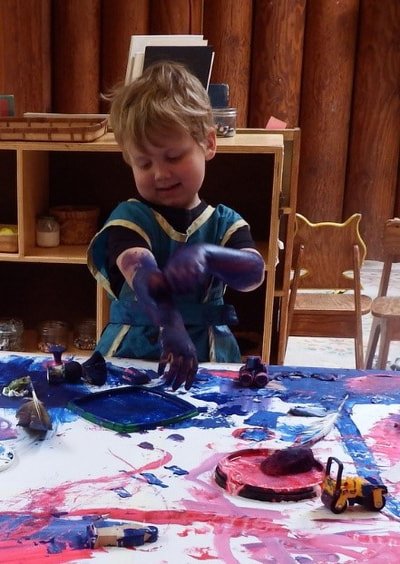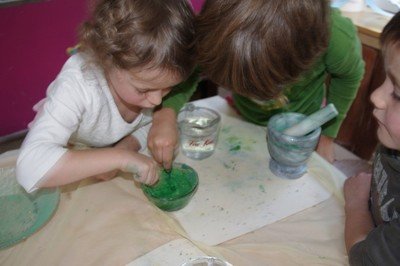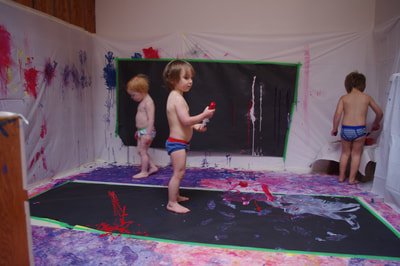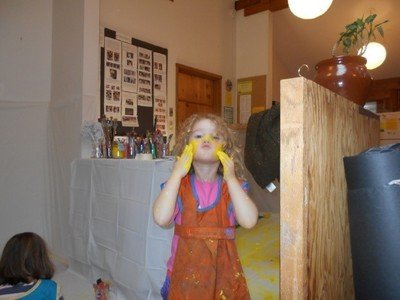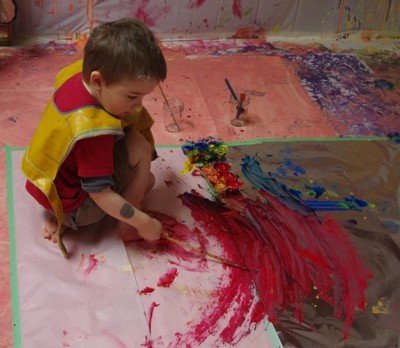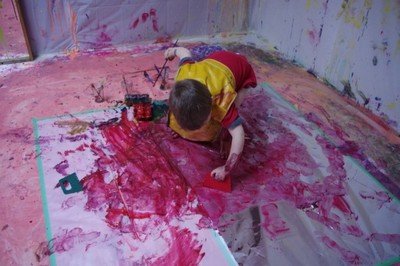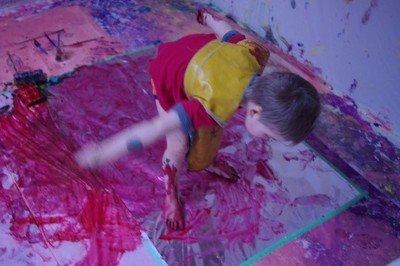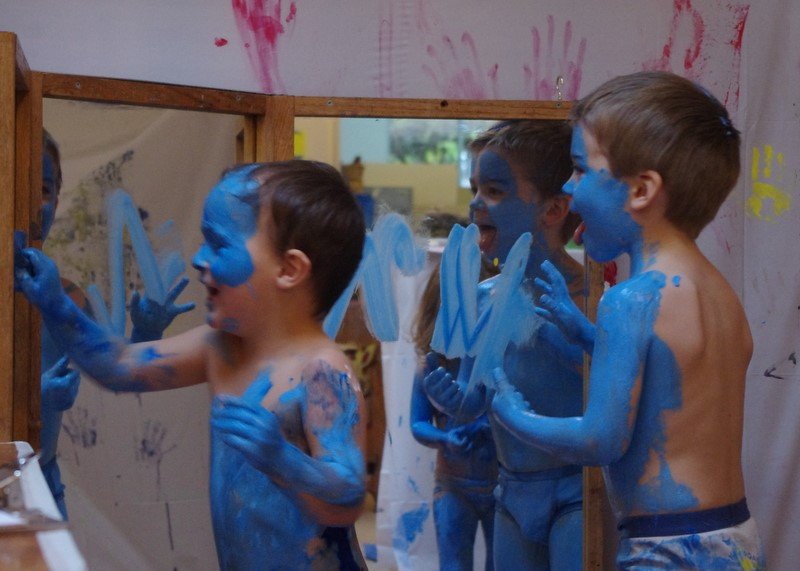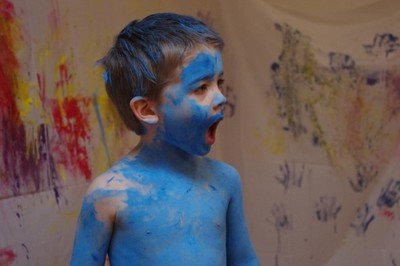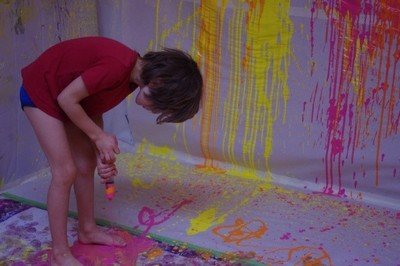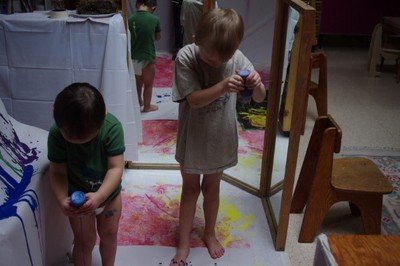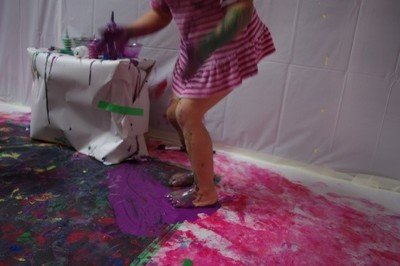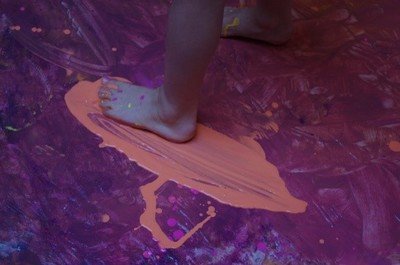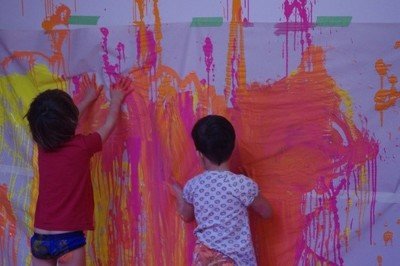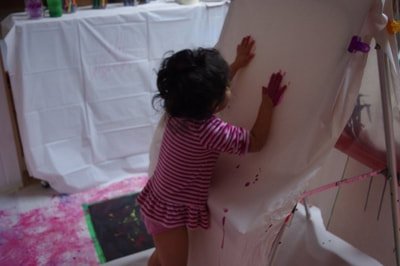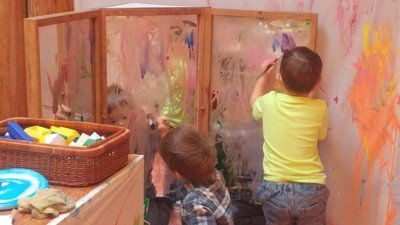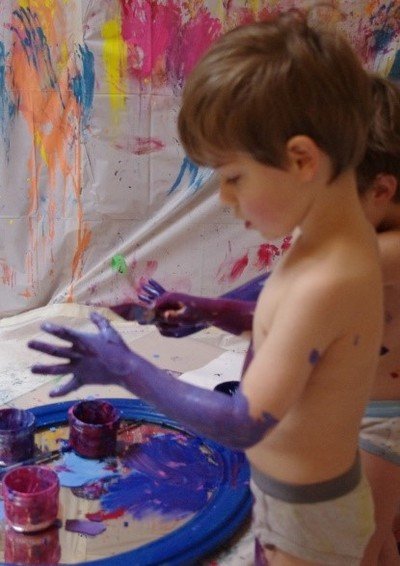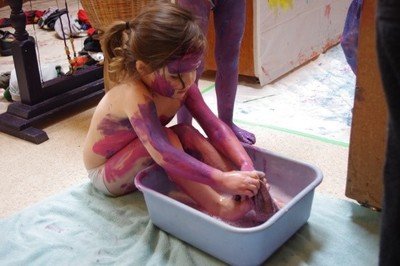Encounters with Paint
September 2017-
We respectfully acknowledge that our encounters with paint have been inspired by the book, “Material Encounters” a catalogue of a project under taken by Capilano University Studio Art Gallery and curated by Sylvia Kind.
How else could we offer the paint to slow the children down? How can we help them join with the paint in different ways?
Children use many different materials (languages) to express their ideas and theories about the world in which they live. We believe that children are intelligent, curious, imaginative, intuitive individuals capable of discovering the properties of each material by creating their own experiments suggested to them by the materials themselves, thus formulating their own theories on how they might use said material to represent their ideas. Instead of thinking of materials as having predictable properties such as colour, shape, density etc. and using them as inanimate objects, what might happen when we consider this: "What if the human role in shaping materials is not as central as we believe? “What if materials shape us as much as we shape them? How might we experience materials differently if we acknowledge them as joint participants in our interactions with them?" (Material Encounters. Kind, 2014 P.3)
“Experimentation opens up worlds, creates new venues for thinking and doing. It actively extends experience.” (Kind 2014, P.3)
With this in mind we embarked upon our exploration of paint.
“These as all the teeth. They are sharp and spiky.” Dylan
The children experimented with the paint, discovering how it worked in relationship with the movement, tools, paper and how it all fitted together.
“It's turning orange.” “It’s rainbow.” “Woe! Mine is way darker than yours!” “You think it's ready?” “Something makes it really dark.” “The blue does.”
Harmony, “I have never done this before, this is fun. This was our experiment. Wow, I made a great idea right? This is so fun. I'm not grinding, I'm just making goop.' Jari, “What about if I am the grinder and you take care of the goop?” Harmony, “We didn't mean to do it, we just added water and we made our own paint!”
Our interpretations of the children's encounters have led us to believe that the children display an intuitive interest in flow, fluidity, transporting and feeling the paint. To extend this we wondered, what can hold, carry, and move paint?
“(Children)...join with materials...Every mark, gesture, and actions becomes a question. What can this material do? What can it become? How can I join its becoming? (Kind, 2014)”
In most of their encounters with the paint the children moved as individuals, as though their experiences and experiments were personal to them. How can we use the paint in a way that would encourage collaboration and a shared exploration of the material? We created the painting area in response to this question.
Within this space your children have experienced paint in a way they have never experienced it before and the paint has truly become a joint participant in it's interactions with the children.
We have observed the collaboration we were seeking between the children and it is beautiful. The paint is a full body experience, a sensory exploration which jives with their natural tendency to explore the world using their senses. They have an unspoken collective understanding of respect for each other and acceptance. With no direction or restrictions from us, they feel free to express themselves and include their friends in their expressions.
They are amazing, in this small space we see them moving quickly in excitement and joy as the paint says, "Spread me", and they do so all over their body. It oozes harmony, the paint is their friend and with it they are building relationships with their peers, the space around them and themselves.
The paint is shaping the children, and their experiments with it are opening new experiences to them. As the paint flows so does their collaboration with others. The paint transforms them and when they look at themselves in the mirror it is as if they are meeting themselves for the first time.
How else could we offer the paint to slow the children down? How can we help them join with the paint in different ways?
When small amounts of paint were offered with small scale tools the children were more deliberate with their movements, swinging, dipping, and observing. They tolerated their friends painting on their backs which they found to be an odd sensation.
The children join with the paint as it slips and slides over surfaces. “If materials are not just static, … but are always already in the midst of becoming something else” (Kind 2014, P. 9) have we given the paint time to react to the children? If there was no time limit would we see a change in the paint? Would we see a change in the children’s movements?
When all the paint was gone, the children showed no signs of being done. As the paint dried the children began scrunching up their faces and opening their mouths wide.
The children and paint slowed reflecting the rhythm of the material itself.
By giving the children multiple opportunities to explore the paint they were able to repeat their previous experiences with it. This repetition strengthened their relationship with the paint.
By giving the children multiple opportunities to explore the paint they were able to repeat their previous experiences with it. This repetition strengthened their relationship with the paint.
Using the tools, they observed the paint. With their bodies, they felt the paint.
They affected the way it moved and were affected by the paint.
The paint transformed them, and the play was imaginative.
We observed their relationship with the paint growing and strengthening, we also observed collaboration between the children as they had these paint events together. The paint binds them together, it is a teacher, it is the instruction of how to be. If this is so, will their bond extend beyond the paint area? Will the children build upon the harmonious experiences they had with their friends with the paint to other areas of the Centre?
A Provocation for Connection
January 8th, 2018 - In our continued effort to provide opportunities for the children to collaborate and strengthen relationships with each other through paint explorations, a long banner was taped to the wall and a group of children were invited to paint with watercolour.
Titus initiated the painting by choosing yellow paint and connecting the experience to the song “Yellow Submarine.”
The other children recognized the song and joined together to make a submarine. They talked and laughed and added details.
As they dipped their brushes in each colour, they quickly discovered that this created a brown and of course the submarine needed a bathroom. The focus shifted to “bathroom talk.” This attracted Beckham who had been observing from the outside who then joined in. With paint brushes in each hand, the children made fast strokes and sang fast songs to match.
Eventually, Eamon and Beckham were left in the paint room alone, a pair not typically seen engaging together.
The boys moved from the mural painting to the mirror. Back and forward they went from the paint pucks and water to the mirror, singing, laughing and communicating with one another through movements and silly noises.
The play was long, and what interested us was how the bond they created in the paint room transferred to the sand table where the two engaged further, happily connecting with one another.
"What concerns us as educators and researchers are relations: the dynamic relations between and across various elements,” (Ketchabaw, Kind & Kocher p.54) In this case, we have been intrigued with the relationship between the children themselves. A previous wondering has been proven; yes, the children can and do transfer their harmonious experiences outside of the paint room confirming that these experiences truly are bringing the children closer together with one another.
Participating; In, Out, and Around the Paint Corner
When Isla, Eamon, and Rosa were in the paint room together I wasn’t expecting to see the collaboration and shared vision that the group of older children demonstrated while creating the submarine. But I was interested to see how they expressed the shared experience of being in the paint room together. They took cues from each other, built on each other’s ideas and imagination and worked co-operatively with the materials. But what I was really interested to see was when the shared experience jumped the boundary of the painting corner and included the children who were observing.
As they made their first explorations with the paint, Dylan who was outside the paint corner watched, and cheered them on; “Good job painting your foot, Isla.” As their explorations with the paint and their bodies became bolder, it went from cheering on to egging on as three boys took to chanting. “Paint your hair, paint your hair.” It was time to redirect this group from egging on, but the participation between the two groups continued.
After painting themselves and peering at themselves in the mirror, Isla, Rosa, and Eamon became paint monsters. Once they roared to each other and the relationship among monsters was settled (Isla declaring, “I am the Mommy monster.”) their attention turned to the group of children gathered to watch them. They menaced them with roars and hands outstretched into claws
Once again, the painting activity was drawing more children into participating.
There were several times when children came to quietly observe the activity. As I looked at them observing intently with smiles on their faces, I am reminded that there are other ways of participating in an activity besides directly participating, or interacting with the participants, and that is a type of inward participation. This goes beyond watching and waiting outside for a turn. Seeing their complete engagement and the smiles on their faces, I imagine that they are able to project a part of themselves into the paint corner with the other children. As they watch I wonder if they can feel the smooth, cool paint on their own skin, and I wonder if they are making decisions about what they would do if they were the ones with the paint brushes in their hand.
Inward participation can be over-looked as a form of participation, but it can also be a rich way of experiencing.
When an activity like the painting corner is offered at the Children Centre, the learning, the relationships, and the participation stretches beyond the corners of the painting area and grows to include more than just the children painting.
March 2nd, 2018
Cleaning up after a paint experience becomes an event in itself.
“Back to normal. Taking off my suit, wash off my Black Panther Suit.” Said Finley. The children strip themselves of the personas they layered on with paint. They take their time to notice the water dripping onto their skin, making the paint run into the tub. Everything a child does deserves recognition. They notice, feel, and experience everything.
Taking care of themselves and the paint room after an event gives the children a sense of well-being and belonging. By helping to clean up gives them confidence in their ability to contribute to our community and an awareness that they are valued.
Conclusion
The Paint Room has inspired so much joy in both us as teachers and in the children. As we have shared this experience with one another, we have discovered endless value in allowing relationships to build in such raw and uninhibited explorations. As the children and the paint mingled, their bodies often became a canvas that brought life to their imaginations. We watched as the children surprised us with the way they inherently “wore” the paint, as if it was dress ups from a tickle trunk. Each instance provided an avenue to safely express and process everyday happenings in their lives. As a group we transformed, morphed and reformed in the whirl of activity that the paint room gave us. This exploration has demonstrated the idea that the materials are our partners with mutual offerings in our encounters with them; the paint affected the children as much as the children affected the paint. The children’s undivided presence with the paint as they engaged with it created a strong foundation for the relationship between themselves and the material to continue to grow. With this authentic exposure we have not only became familiar with the many properties of paint as it reacts with our own interpretations, we have practiced how to share ideas, how to be heard in a group and how to honour and support the positions of our friends. It was with satisfaction and a sense of accomplishment that we dismantled the paint room. Although this ends the first chapter of our relations with paint, we will continue as we shift our environment to include the outdoors. As we move forward, we will keep in mind what we have been taught thus far and look for ways to enhance and expand on this learning.


